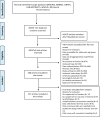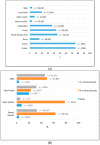The Dietary Intake and Practices of Adolescent Girls in Low- and Middle-Income Countries: A Systematic Review
- PMID: 30558128
- PMCID: PMC6315365
- DOI: 10.3390/nu10121978
The Dietary Intake and Practices of Adolescent Girls in Low- and Middle-Income Countries: A Systematic Review
Abstract
In many low- and middle-income countries (LMICs) the double burden of malnutrition is high among adolescent girls, leading to poor health outcomes for the adolescent herself and sustained intergenerational effects. This underpins the importance of adequate dietary intake during this period of rapid biological development. The aim of this systematic review was to summarize the current dietary intake and practices among adolescent girls (10⁻19 years) in LMICs. We searched relevant databases and grey literature using MeSH terms and keywords. After applying specified inclusion and exclusion criteria, 227 articles were selected for data extraction, synthesis, and quality assessment. Of the included studies, 59% were conducted in urban populations, 78% in school settings, and dietary measures and indicators were inconsistent. Mean energy intake was lower in rural settings (1621 ± 312 kcal/day) compared to urban settings (1906 ± 507 kcal/day). Self-reported daily consumption of nutritious foods was low; on average, 16% of girls consumed dairy, 46% consumed meats, 44% consumed fruits, and 37% consumed vegetables. In contrast, energy-dense and nutrient-poor foods, like sweet snacks, salty snacks, fast foods, and sugar-sweetened beverages, were consumed four to six times per week by an average of 63%, 78%, 23%, and 49% of adolescent girls, respectively. 40% of adolescent girls reported skipping breakfast. Along with highlighting the poor dietary habits of adolescent girls in LMIC, this review emphasizes the need for consistently measured and standardized indicators, and dietary intake data that are nationally representative.
Keywords: adolescent girls; developing countries; diet; dietary practices; energy intake; nutrition transition.
Conflict of interest statement
The authors declare no conflicts of interest.
Figures







References
-
- Sheehan P., Sweeny K., Rasmussen B., Wils A., Friedman H.S., Mahon J., Patton G.C., Sawyer S.M., Howard E., Symons J., et al. Building the foundations for sustainable development: A case for global investment in the capabilities of adolescents. Lancet. 2017;390:1792–1806. doi: 10.1016/S0140-6736(17)30872-3. - DOI - PubMed
-
- United Nations World Population Prospects. [(accessed on 17 May 2018)];2017 Available online: https://population.un.org/wpp/
-
- United Nations, Youth Population Trends and Sustainable Development. [(accessed on 17 May 2018)];2015 Available online: http://203.187.160.132:9011/www.un.org/c3pr90ntc0td/en/development/desa/....
Publication types
MeSH terms
Grants and funding
LinkOut - more resources
Full Text Sources

